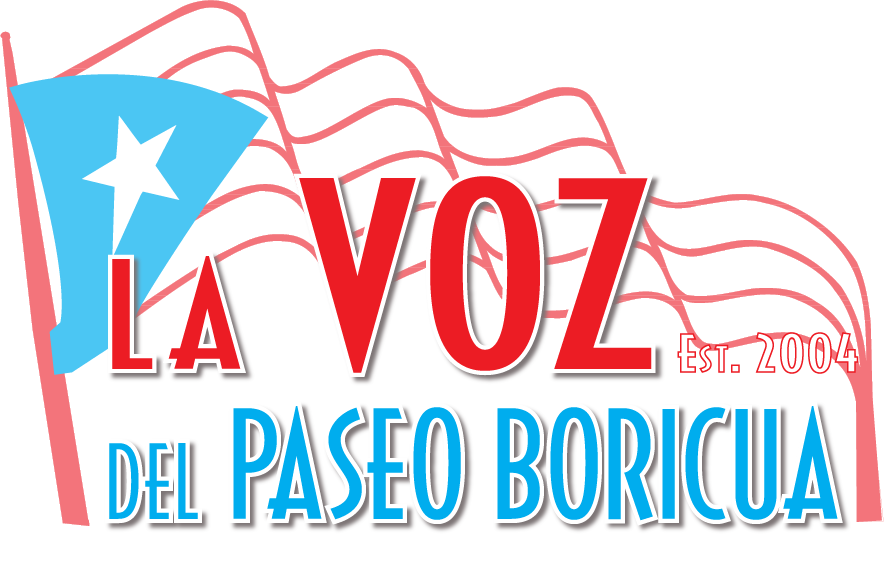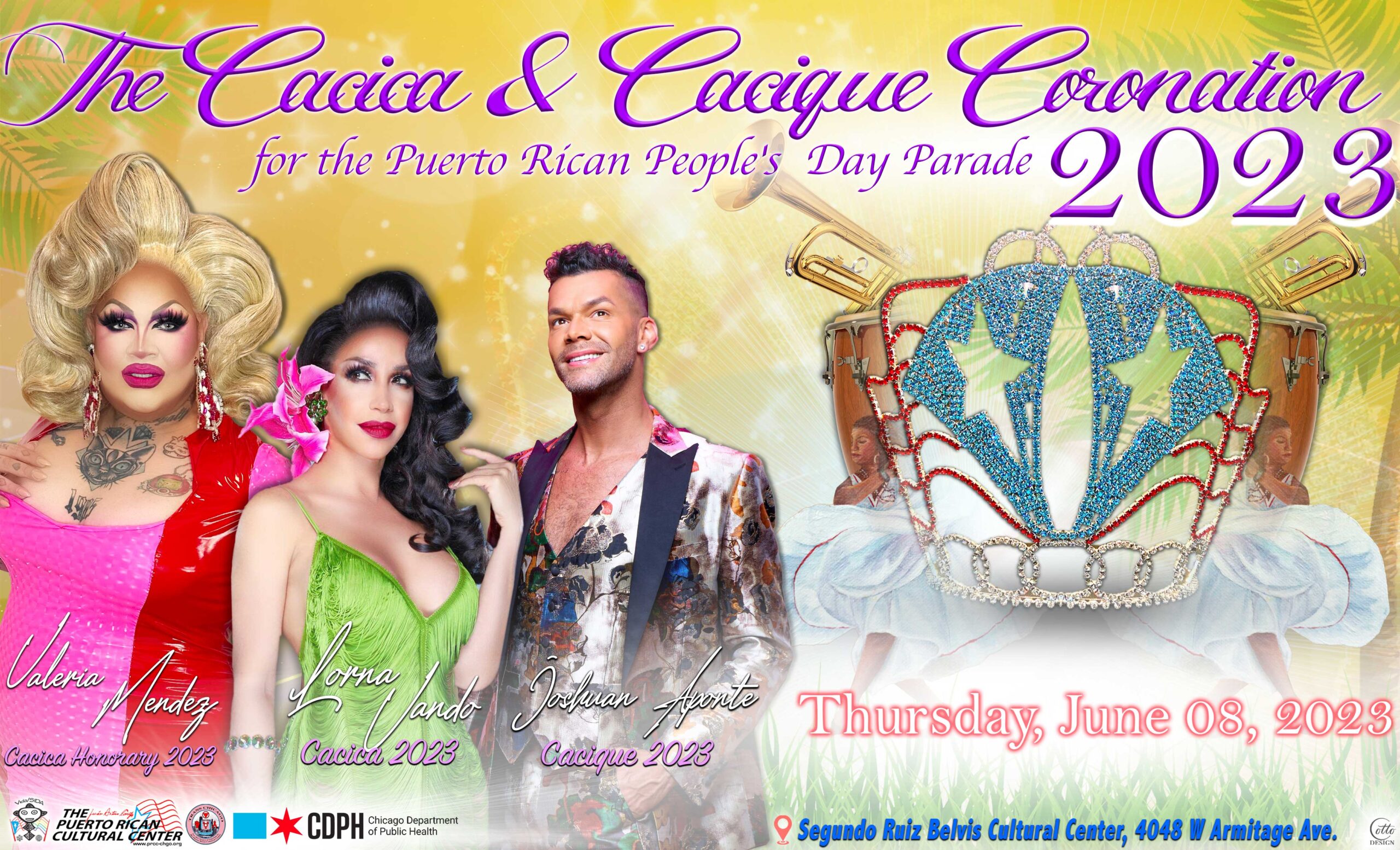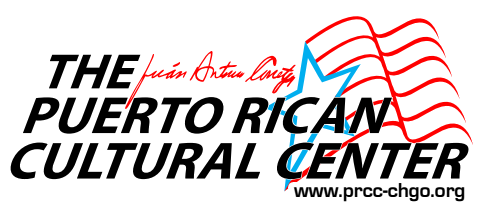As The Puerto Rican Cultural Center looks to celebrate its 50 year anniversary, we look at the community of Paseo Boricua and Humboldt Park to see so many powerful reminders of the wins this Puerto Rican community has achieved through 50 years of grassroots organizing. There are wins represented by the beautiful Flags of Steel on Division, there are wins represented in each community mural, and there are wins represented in the site for the new Paseo Boricua Arts building. However, there are wins The Puerto Rican Cultural Center has had that members of the community have not seen. Many people do not realize the decades of grassroots organizing and solidarity The Puerto Rican Cultural Center has maintained with those on our beloved island of Puerto Rico. Since the foundation of the Center, organizers in Chicago have stood in solidarity with Puerto Rico to demand the release of Puerto Rican political prisoners, to stop dangerous mining projects on the island, to expel the U.S. Navy from Vieques, to provide financial, material, and organizing support to Puerto Rico in the aftermath of Hurricane Maria, and most recently to help fund a community resilience center in La Juncia, Comerío, which will provide service to more than 700 people in the event of a hurricane. The facility contains kitchen, laundry, and bathing facilities, all with their own generator. It should be noted as well that in no way was support ever done through charity. The Puerto Rican Cultural Center has always supported efforts led by Puerto Ricans on the island that truly speak to the Center’s mission of self determination, self actualization, and self-reliance. To kick off The Puerto Rican Cultural Center Juan Antonio Corretjer’s 2-year long Golden Anniversary celebration the Center took a trip to Puerto Rico to connect the Diaspora to the organizations on the island who we have worked with over the years.
While we were meeting with our compatriots on the island, we are grateful to report we were able to give monetary donations of nearly $5,000 to community initiatives in five towns in Puerto Rico (see eco-tour summary below.) These donations would not be possible without the generous monetary contributions given to The Puerto Rican Cultural Center by all the people who believe in our work. We want to express our deepest gratitude to those who have made such contributions to our work -without you we could not have done it. We hope that we can continue to count on your generosity.
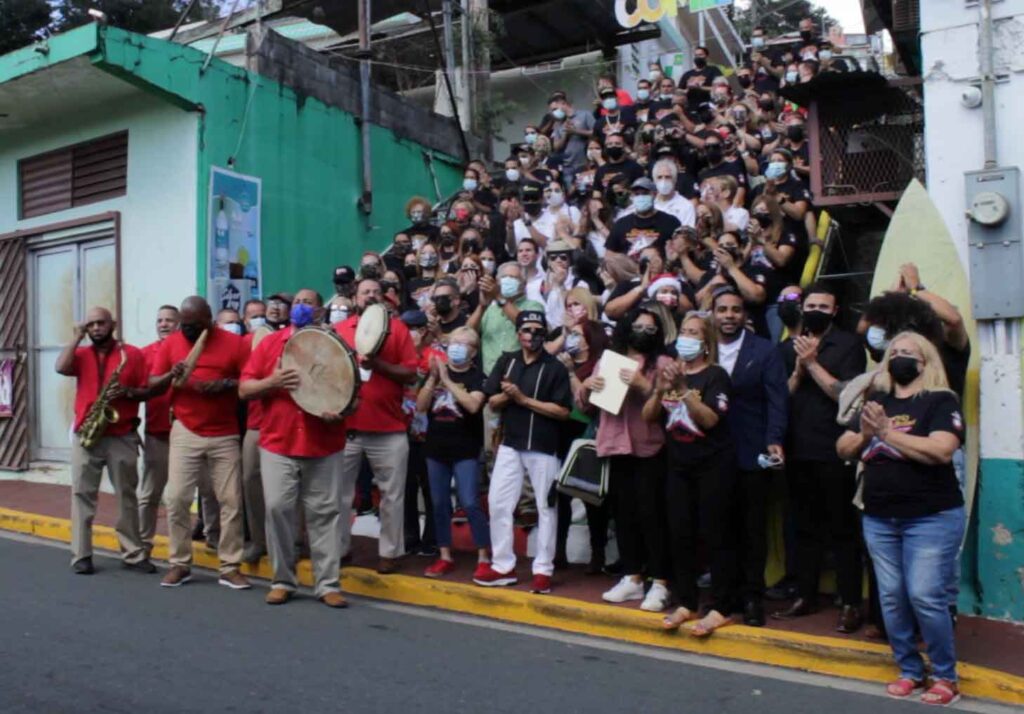
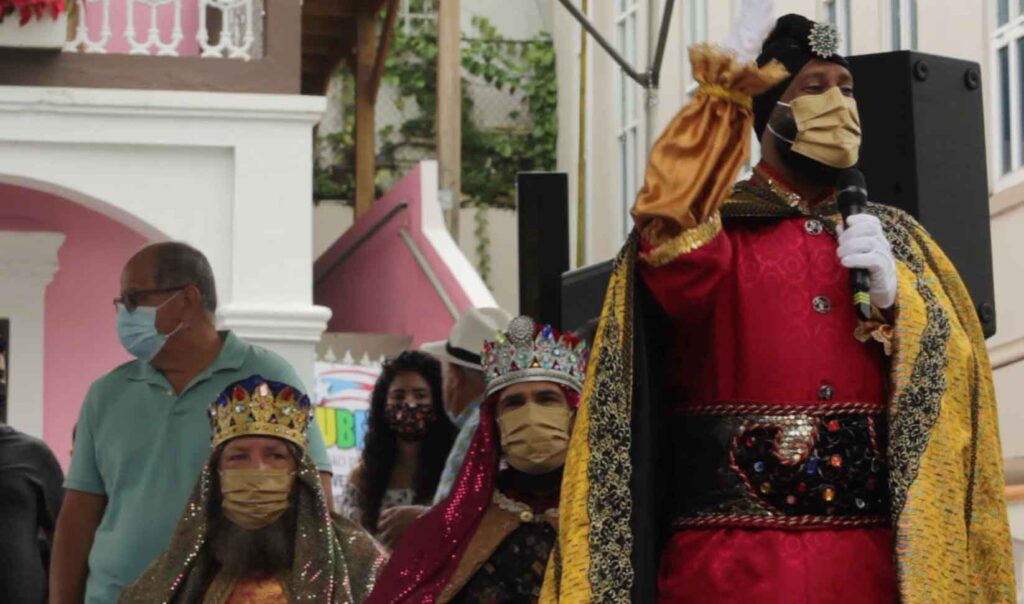
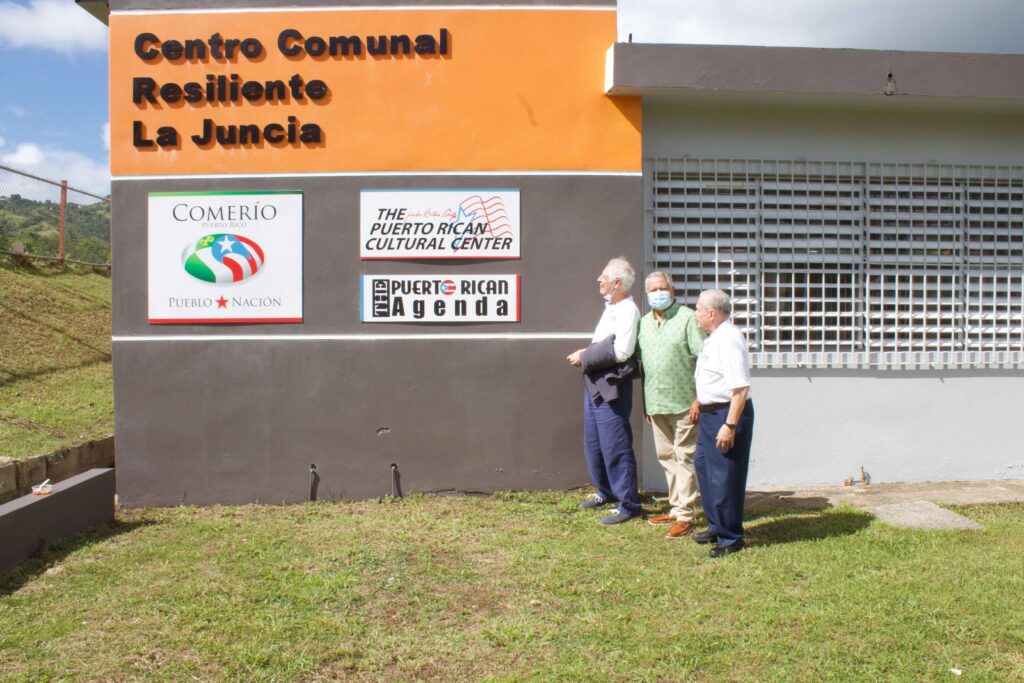
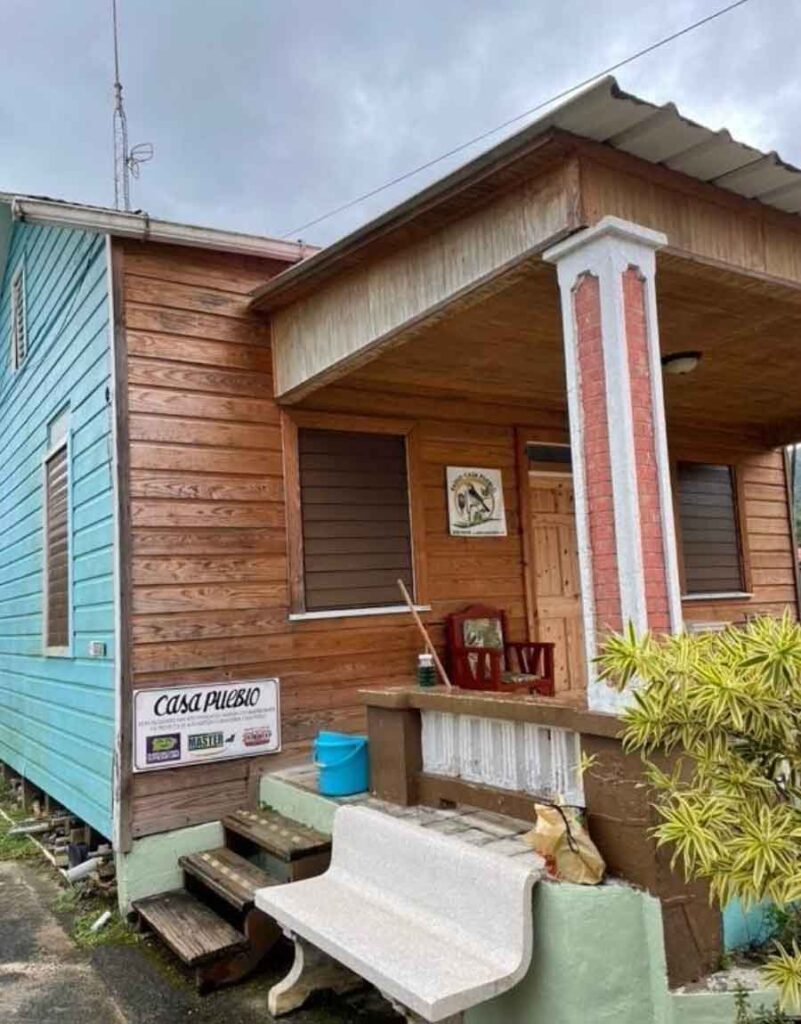
Puerto Rican Cultural Center Eco Tour Highlights:
The PRCC organized an educational ecotour of Puerto Rico that included 16 participants visiting 11 towns. Between December 15 and 25, the participants were challenged to engage their critical consciousnesses and gain a more profound understanding of the problems and the possibilities of Puerto Rico today. Among the topics investigated was a deep look, through a processes of self-actualization, into the grass roots initiatives that address the island’s systemic challenges. The highlights of the trip included the following:
On Friday, December 17th: At sunrise we celebrated the traditional Puerto Rican Misa de Gallo, and were graciously hosted by Father Raúl and the congregation of San Andrés de la Montaña Catholic Church in Barranquitas. Later we attended the inauguration of Comerío’s first community resilience center in the community of La Juncia. During the inauguration, The Puerto Rican Cultural Center and the Puerto Rican Agenda were honored for their critical support in developing the resilience center (which will serve more than 700 people of La Juncia including laundry, kitchen, and bathroom facilities) and in providing aid to the community post Hurricane Maria. For lunch we were treated to lechón asado en la barrita at an incredible project in Comerío offering alternative education to students in Puerto Rico who have been pushed out of the Puerto Rican public high school system. The school is located on a 20-acre farm that provides students with creative engagement in culinary arts, visual arts, and other vocational skills. We were then taken to a housing and educational center for abandoned children with physical challenges from ages 0-5. After visiting the school, the delegation made its way to the plaza of Comerío where we were welcomed by an amazing parranda comerieños, which was followed by the initiation of el Festival Jíbaro.
On Saturday, December 18th: The Chicago delegation enjoyed two incredible exhibits by Antonio Martorell and Agua, Sol, y Sereno at el Museo de Arte de las Américas in San Juan. Later during the day, we were warmly welcomed by artists: Ana Rivera and Charles Juhasz-Alvarado and given a beautiful tour of La Casa de los Contrafuertes/ a space for local artists that includes workshops, gallery spaces, and a garden.
On Sunday, December 19th: The Chicago delegation was treated to a very special breakfast at the home of Comerío’s Mayor Josean Santiago. We then were witness to a traditional Santa Misa led by Father Pedro in Comerío’s Plaza de la Trova: The mass was musically performed by Puerto Rico’s legendary musical group la Orquesta Nacional Mapeyé and featured Los Tres Reyes Magos de Juana Díaz. After the misa, we enjoyed Comerío’s 41st annual Festival Jíbaro with traditional food, drinks, artisanry, and live music including the island’s best trovadores as they competed on the main stage. The festival hosted more than 100 artisans and culminated with an amazing performance by Andrés Jiménez, el Jíbaro.
On Monday, December 20th: We visited the grass roots initiative Casa Pueblo in Adjuntas and learned about the incredible work they are doing to support the self-actualization and self-reliance of the Puerto Rican people in Adjuntas. We learned about their work to bring solar power to their pueblo, how they provided relief and electricity to their community post Hurricane Maria, how they sustain themselves with the sales of their homegrown coffee (Madre Isla), and how they utilized their solar powered cinema and radio station as a form of therapy/storytelling post Hurricane Maria. After Casa Pueblo, we had lunch with the iconic Puerto Rican artist Anotonio Martorell, and took a tour of his studio in Ponce. During the visit to Ponce our Executive Director and COO were able to meet with the Mayor of Ponce, Dr. Irizarry Mora, to discuss Ponce’s participation in the 29th Fiesta Boricua in September to represent “Lo Mejor de Nuestros Pueblos, since next year the PRCC will be celebrating its 50th anniversary and our first initiative was the Dr. Pedro Albizu Campos High School, and Ponce was the birthplace of the school’s namesake.
On Tuesday, December 21st: We took the ferry from Ceiba to the beautiful island of Vieques to meet with the legendary Roberto Rabín and María Pagán in el Fortín to hear them recount their stories of how they fought to get the U.S. Navy expelled from Vieques, and the fight they are continuing to force the U.S. Navy to clean up the toxic waste left after decades of bombing the island. We were treated to a tour of the island from Isabel to Esperanza, Vieques’ largest settlements. The group was able to savor some of Vieques’ wonderful cuisine.
On Wednesday, December 22nd: We took a deep dive into the complexities of coffee production in Puerto Rico with the Mayor of Ciales at el Museo de Café, where we learned how Puerto Rican coffee is grown. Later we witnessed the process that coffee undergoes at the agrocomercial coffee cooperative in its Torrefacción in Frontón, Ciales, where Cibales coffee is produced. In Ciales we also visited Casa Corretjer where we got to learn in depth about Juan Antonio Corretjer’s life and legacy with a tour given to us by our Puerto Rican patriot, Luis Rosa. After Ciales, we went to the workshop of Juan Villalobos to see how he makes Puerto Rican wood furniture using traditional Taíno weaving techniques. Finally, we ended the day in Barrio Coabey, Jayuya where we visited Casa Canales and the sacred Taíno batey in the valley of the Gods.
On Thursday, December 23rd: We traveled to Maricao where we were welcomed by the Mayor of Maricao Wilfredo “Juny” Ruiz, who personally prepared coffee from Maricao for us. Later we were taken to see the beautiful forest of Maricao and its highest peak (Monte del Estado), one of the homes of the Iguaca parrot. Our gracious hosts in Maricao were Angie Baiges and her partner Edwin. We ended the day in San Sebastián with a delicious dinner at the home of Millo, and beautiful classical guitar performed by San Sebastián born Hermelindo Ruiz Mestre.
On Friday, December 24th: We ended the trip in Loíza where we were welcomed by the Mayor of Loiza, Julia Nazario, and some of the members of Junte Loizeño, who served a traditional Loizeño lunch and offered us an amazing performance of Loíza’s incredible Afro Caribbean bomba. It also included a guided tour through the Cueva María de la Cruz.
During the visit our executive director and our chief operating officer engaged various mayors and leaders of civil society in discussions regarding advocacy and policy at the federal level for Puerto Rico as well as the intersectionality of these with the Diaspora.
The PRCC presented checks to the following town towns to purchase toys for the Three Kings Day celebration: Municipio de Maricao $500.00, Municipio de Loíza $1,500.00, Centro Cirillo Meijer in Comerío $1,000.00, additionally $500.00 Casa Pueblo, and $500.00 archivos históricos Vieques.
Reflections from Eco-Tour Participants:
The following reflections are from some of the participants of The Puerto Rican Cultural Center’s eco tour about their experiences.
Marisel Vera: We drove up the mountains in Jayuya to El Cemí Museo and we walked the hallowed grounds where our Indigenous ancestors once walked. Pedro Albizu Campos would come to this sacred place to meditate. José invited our group to stand en el batey that was encircled in stones and to close our eyes; I closed my eyes. “Listen to the birds” he said, and I saw a seagull fly from right to left, and a small bird soar from left to right; “Listen to the trees”, he said, and I heard the rustle of leaves at my back; “Feel the wind”, he said, and I felt the breeze in my hair. When José said that every Puerto Rican that he had brought to El Cemí had felt the energy of our indigenous ancestors, I felt a rush of vibrations from my wrists down to my fingertips. Awed, I knelt down on the ground and touched the small stones, offering thanks to my ancestors for my blessing.
Jane Nicholson: We were a group of sixteen, amplified by heroes Oscar Lopez and Luis Rosa. Many of us were new to one another with varied interests—all the better to connect with all that was in store for us. Our journey was a constant revelation of how to build and sustain community. Some of the communities that greeted us shared a great common goal, while others worked together despite different outlooks. We saw deeply into what community mayors wanted for their regions and how social networks were constructed and tended to. Comerío was our host community and included us in their Festival Jíbaro where the plaza served as a concert venue and open-air church. We clapped endlessly to rhythms and the spontaneous arts of the trovadores, as we slid into the heart of tradition. Other arts–such as master Antonio Martorell’s studio and the installation at Casa Pueblo in Adjuntas where butterflies are sheltered, Café Madre Isla roasted, climate change studied, and solar energy distributed, or the delightful La Casa de les Contrafuertes with its medicinal plant garden and limbers on offer in San Juan—immersed us in knowledge and commitment. The beach at Carolina, the stunning peaks and valleys of the Cordillera Central, the coastlines of Loíza, and the Island of Vieques, a place of beauty pock-marked by the unthinkable violations of the US Navy, wrapped us in splendor. Throughout, thoughts of the unique struggles of an island nation and thoughts of exploitative colonial relations with the U.S., were countered by brilliance and fortitude. We could see how much had been rebuilt after Maria—new and strong and then one house–in the middle of a small group enroute to the marvelous Forest Reserve of Maricao–remained dirt-streaked and covered in writing where one bit stood out: ME VOY. We were nourished in every way by our hosts and a vibrantly lived-in place, and though we brought gifts, I feel gently but urgently tethered to these communities by profound gratitude and the will to reciprocate. As preciously, other unimaginable itineraries are underway in Humboldt Park.
Xiomara Rodriguez: This trip to Puerto Rico showed me a Puerto Rico I have never known before. Growing up I remember hearing so many negative stereotypes about Puerto Ricans in the media about us being lazy, unintelligent, incapable, needing the U.S. for welfare and governance, etc. As a Puerto Rican I knew these stereotypes were wrong, but being on this trip and seeing the work of the Puerto Ricans we met instilled a feeling of profound pride in my people like I have never felt before. Everywhere we went we heard the same story of how people began their work when they faced the realities of government neglect and corruption in Puerto Rico, and made the decision to meet their community’s needs themselves. It was incredibly inspiring to see people deciding to be self actualized and self determined rather than waiting on a government that truth be told owes reparations to Puerto Ricans far beyond any social security check. Almost everywhere we went on the island people said they were without power or water for six months after Hurricane Maria, and the government aid was little to nothing. It was people on the island who worked together to help people survive the neglect. We met with people from Casa Pueblo who have been working to make Adjuntas energy independent using solar power. They told us that the whole time people in their community were powerless they opened up their space, so people could connect to power and refrigerate things like breast milk and medicine. We heard from the community of Comerío where the community members organized brigades amongst each other to go into the mountains to rescue power lines and restore power after Hurricane Maria. We heard from activists who put their lives on the line to expel the U.S. Navy from Vieques, and who are now fighting cancer like many people from Vieques as a result of the toxic waste the U.S. Navy left on the island. I was surprised that everywhere we went people expressed such deep gratitude to us for our continued support in the Diaspora of all of their work. As an employee of The PRCC, I did not realize the extent to which our work in Chicago affects the island. The whole trip made me feel so proud to be a Puerto Rican, to work somewhere that has helped my beloved island in so many ways, and I felt inspired to work even harder to grow this movement in Puerto Rico towards self determination!
Ignaik Cruz: El viaje fue muy interesante. Pude ver a partes de Puerto Rico que yo nunca había visto pero también fui a lugares donde yo me crié. Me enseñó el valor del cafè, de las amistades, y de las personas nuevas que nos enseñaron una humildad tremenda. Y también me enseñó el impacto que El PRCC ha hecho en los lugares con mayor necesidad y la gratitud que esas municipalidades tienen con lo que se le da.

